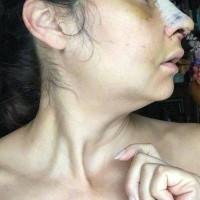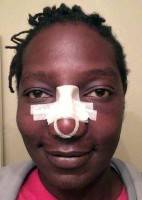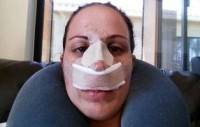Rhinoplasty Recovery And Results Timeline
After nose job, a splint is placed over the nose for one week. By then most of the swelling is down and even with the remaining swelling the nose will show its new shape.
At that time most people can return to work looking presentable but have to refrain from physical activity for another two weeks. Most noses take between 6-12 months to settle down and acquire their final shape. (Raja Srour, MD, Los Angeles Plastic Surgeon)
Although the swelling takes a full year or more to completely go down, most patients can return to work in a week. By that time the bruising has largely or fully resolved, and the swelling has resolved to the point that the nose looks natural, even though the final result takes a long time. (Thomas A. Mustoe, MD, FACS, Chicago Plastic Surgeon)
Recovery will vary from patient to patient. Early recovery after nose job generally takes one week. At the one week visit, the external cast and any sutures are removed.
In two weeks you may generally return to running/light exercise, while return any contact sports requires at least six weeks. Bruising can frequently last for one to two weeks, but the degree of bruising will often depend on whether the bones must be fractured as part of the surgery.
Swelling will improve significantly by about two weeks after surgery, but will continue to improve even out to twelve months. (Josh Surowitz, MD, Raleigh-Durham Facial Plastic Surgeon)
There is some swelling and bruising after surgery that usually last about 8-10 days. There is some discomfort the night of surgery that is treated with mild analgesics.
The splint and the internal stents are removed in 8 days. All of the stitches are dissolvalble. The nose usually looks better immediately after removal of the splint but it may take as long as a year to see the final result. (Bahman Guyuron, MD, Cleveland Plastic Surgeon)
Most patients take a few days off from work or school. All of my patients wear a protective nasal splint for 5-6 days after surgery.
Most patients are off of pain medication after a couple of days. Bruising is usually minimal. I do not use internal nasal packing. (Scott C. Sattler, MD, FACS, Seattle Plastic Surgeon)
Recovery Time From Rhinoplasty Surgery
Recovery from rhinoplasty can vary but in general, I tell my patients to expect a week of downtime. At the one week mark we remove splints, and sutures. Sometimes there is residual discoloration from bruising in the cheeks. This bruising can be camouflaged with some makeup.
The nose is swollen at this time but the overall look of the nose will be evident. Within a few weeks much of the visible swelling will resolve. It takes another 6 to 12 months for the firmness, and the tip swelling to dissipate.
Most patients will return to work or school after the first week. Intimacy, and Light exercise such as the recumbent bicycle can be started at the two week mark. Aggressive aerobic exercise such as Bootcamp and Crossfit can be started at 8 weeks. (Christopher Khorsandi, MD, Las Vegas Plastic Surgeon)
Recovery after rhinoplasty
I usually tell people to plan on 6-10 days off work with limited exertion for 2-3 weeks and avoidance of any sort of contact activity for 6 weeks. (P. Daniel Ward, MD, Salt Lake City Facial Plastic Surgeon)
Rhinoplasty recovery is usually smooth
Typically patients feel very good one week after surgery. If the patient has had osteotomies (bone cutting) there may be more bruising and a slower recovery. Most patients return to work within a short time frame and can resume normal activities. (Robert Mounsey, MD, Toronto Facial Plastic Surgeon)
Rhinoplasty surgery is generally described as fairly comfortable with minimal discomfort post procedure.
Many patients liken it to having a head cold. You should definitely prepare for a good weeks rest after the operation and I would generally recommend two weeks off work. You should refrain from wearing glasses of any kind for 6 weeks after the surgery. Your nose will be tender to touch for several months post op so all care should be taken to not knock the nose or touch it unnecessarily. Driving after rhinoplasty really depends on an individual’s rate of recovery and how much swelling they experience. It is generally best to abstain from driving for about 10 days. Swelling and healing post procedure subside in most cases within 4-6 weeks and total healing time is generally 3-6 months. (Keith Mutimer, MBBS, FRACS, Melbourne Plastic Surgeon)
How long does it take to recover after rhinoplasty?
Most people considering rhinoplasty want to know the answer to two questions. When will I be able to go out in public?
And, when will I see the change I am looking for? The first answer is easy. Within one week after surgery, bruising and ‘social’ swelling should be essentially gone.
After one week, most every patient is comfortable returning to work or school and seeing people socially. That being said, your nose will not feel to you to be entirely normal yet.
It may be a little numb and stiff, and your smile may feel tight or awkward. But, this should not really be noticeable to anyone else.
Most patients tell us that no one noticed anything different unless they had told others they were having surgery. On the second question, you should be seeing noticeable improvement in your nose even within a week or two after surgery.
But, it will take some time before your nose starts to look like the imaged or imagined result. We are talking here about detail or refinement.
The skin has been lifted and changes made to cartilage and bone, and it takes months for the skin to contract and show detail.
Some factors can affect this timing although there is a fair bit of individual variation depending on the extensiveness of surgery.
Thicker skin in general takes longer to contract. Surgery in which the nose was made smaller will take some more time for skin to shrink down to the new level.
Revisions can sometimes be slower to heal although not always. If a large amount of scar was taken out during a revision and cartilage resupported, the skin will likely be able to drape better more quickly. Some patients look like their imaged photos after 3 months. Others may have some fluctuating puffiness and continued improvement well over a year or longer after surgery.
Things can be done along the way to help swelling go down as quickly as possible. It’s best to talk to your surgeon to get a sense of your expected course of healing. (Jason Litner, MD, Beverly Hills Facial Plastic Surgeon)
What is the typical rhinoplasty recovery like?
The recovery after rhinoplasty is not difficult or painful. Patients do complain of a stuffy nose after surgery for the first week or so, but they don’t complain about alot of pain. I give Tylenol #3 (Tylenol with Codeine) wich is gentle pain medication and many patients take only plain Tylenol or a small amount of the Tylenol #3.
Most patients take one week off of work. Although the nose is still swollen, it is a better shaped nose at that point. I tell patients not do anything strenuous, no bending or lifting for the first 2 weeks after surgery. Most of the swelling has resolved by the end of the first month. (Jonathan Pontell, MD, FACS, Philadelphia Facial Plastic Surgeon)
Rhinoplasty recovery today surprisingly fast.
Rhinoplasties with today’s techniques, fortunately, are not a long recovery. Most of my patients are pleasantly surprised by the experience. Although there is some discomfort, most patients describe it as less than they would expect.
Typically after surgery patients have tape and a splint on their nose for one week. They also have absorbable stitches in the nose and often a few stitches underneath the nose that need to be taken out. Shortly after that first week when the stitches, tape and splint are removed, the patient can wear makeup.
Even with this, patients will have swelling oftentimes for several weeks after surgery. Nevertheless, I tell my patients that I would full expect them to be comfortable getting back out in the public by two weeks. Patients typically are asked to restrict their activities for the first two weeks and no heavy lifting for three weeks. In addition, patients should not do any contact sports for six weeks.
After surgery, patients should expect to take a full year before they see their final result. While some of the effects of surgery can be seen right away, others especially in the tip region will take up to a full year to see the final result.
Patients undergoing rhinoplasty should know that some patience is required but in the long run they will be able to appreciate the results that they want. (Mark Hamilton, MD, Indianapolis Facial Plastic Surgeon)
Every person is different, but most people will take 7-14 days off of work. By day 3-4 you will be feeling pretty good, but have a splint. We take off the splint at day 5 then place tape over the nose until day 10. At day 10, you will not have anything on your nose to indicate that you had surgery and most of the swelling in your eyes and cheeks will be resolved.
Most people will be ready to go back to school or work at this time. Some people, especially if you are fair skinned, may have bruising that can last up to 14 days.
So, it depends on your work environment and how many people know you are having this done. Your nose will be swollen, 90% of the swelling goes down in the first 3 months and the last 10% goes down over a year. However, this is swelling that you will notice, but not other people. (Angela Sturm, MD, Houston Facial Plastic Surgeon)
Recovery time after rhinoplasty
The recovery time is dependent on many factors, the most important being whether you need an open vs closed rhinoplasty. The amount of “tip work” and nasal bone fracturing that is required.
The external splints usually stay on for 7-10 days. Internal splints usually stay in for 2-4 days, if you need a septoplasty or turbinate reduction. At 2 weeks you are ready to return back to work as most of the bruising has resolved (even quicker if you are happy to go to work with the splints on).
You will remain swollen, especially at the tip for several months but only you and your PS will notice this. (Pouria Moradi, MBBS, FRACS, Sydney Plastic Surgeon)
Rhinoplasty Recovery Expectations
Rhinoplasty recovery will vary person to person depending on the type of rhinoplasty being performed and the individual patient. Generally speaking, after your surgery, you will have swelling, bruising, and tenderness that may last for several days.
The initial swelling can remain for 5-7 days, but bruising generally worsens by days 3-4 and can last up to 3 weeks. You may have a splint on your nose that will be removed at your follow-up with your surgeon at 5-7 days.
You should be ready to return to work after 1 week. (Jeffrey W. Hall, MD, Austin Plastic Surgeon)
What to expect from your rhinoplasty recovery
Knowing what to expect is really important and patients who have been well informed by their surgeon and their staff do very well. Generally speaking, the recovery is easier than what most people are planning for.
Our patients continually report to us that the worst part about recovery is: stuffy feeling in the nose – this is because of the swelling and usually lasts about a week being stuck in the house – there is no need to stay home, but many patients do because they are embarrassed to be seen with a cast, bruising and swelling
The link below is to a webpage that provides detailed information about what to expect from rhinoplasty recovery week to week, and how much time you should take off work. If you’d like to see how someone looks at their cast removal visit (1 week post operative) see the video below. (Thomas Buonassisi, MD, Vancouver Facial Plastic Surgeon)
Most of my patients are able to return to work or school after one week. A splint is worn on the outside for the entire week after surgery. During the first few days after surgery it is important to keep your head raised and apply ice as much as possible. This will decrease your bruising and swelling. Patients who are good about this have significantly less swelling and recover quicker.
The surgery is surprisingly not painful because there is a lot of long acting numbing medicine used. You will feel stuffy and congested with a mild to moderate dull discomfort – totally tolerable. When the splint comes off after the week you should see avery nice improvement but there will be natural swelling that will take time to resolve. You should be happy by three weeks and loving it by three months. You must be patient. It will continue to improve for even a year as the final amount of swelling leaves. (Ronald Schuster, MD, Baltimore Plastic Surgeon)



